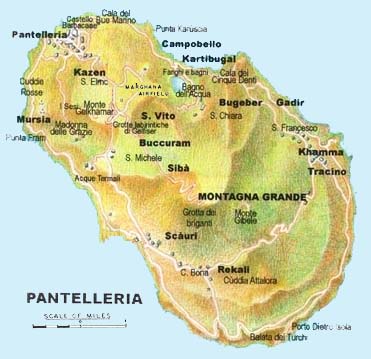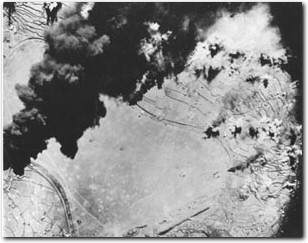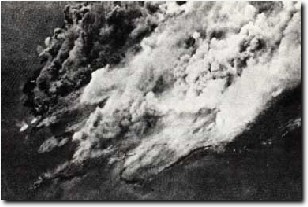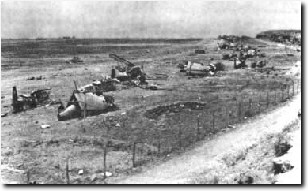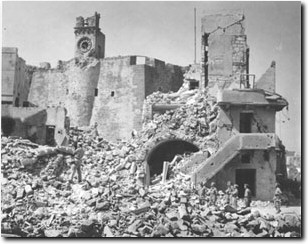![]()
Blitzkrieg
on Pantelleria
by Victor
C. Tannehill
|
|
|||||||||||||||||||||
|
|
As a result of a strategic decision made at the Casablanca Conference in January, 1943, the invasion of Sicily had been scheduled for July. But before such an invasion could safely be launched, the Allied Commander-inChief, General Dwight D. Eisenhower, felt that the Italian outpost island of Pantelleria (and three smaller islands to the south, Lampedusa, Lampione and Linosa) would have to be taken.The result would be allied control of the Sicilian strait. The operation was called Operation CORKSCREW. The importnace of Panteleria Island resulted from its location. It was right in the middle of the Mediterranean Sea being 53 miles to the east of Tunisia and 63 miles to the southwest of the island was Sicily.
Considered by many to be an impregnable military fortress, Pantelleria was studded with heavy gun emplacements and well-concealed batteries. Indeed, Aerial reconnaissance over the 42-square mile rock island revelaed more than 100 gun emplacements, embedded in rock or concrete. It had a garrison of some 10,000 troops. The enemy had Freya radio direction finder stations on Pantelleria with enough range to detect Allied planes taking off from North African airfields. Those stations would prevent tactical surprise for any Sicilian invasion. The Island held an estimated eighty German and Italian fighter planes on its Marghana Airfield, along with a number of bombers. Its various coves and grottoes sheltered motor torpedo boats and submarines that would pose a serious threat to an Allied invasion convoy. So, in the hands of the enemy, Pantellena constituted a grave menace to our Sicilian operation. On the other hand, the capture of the Island and its airfield would provide an excellent base for Allied fighters to protect our shipping and to furnish close support for our landing forces on Sicily. By early May, 1943, plans to take Pantelleria had been drawn up under the code name Operation CORKSCREW. An amphibious assault was set for June 11th Even before the enemy surrender in Tunisia on May 13th, Northwest African Air Force (NAAF) attacks began against Pantelleria and continued throughout that month on an increasing scale. Fighter-bombers, mediums and heavies pounded away at the Island's defenses.
They began by wrecking the airfield, destroying numerous aircraft on the ground. Then they sank the ships in the harbor. This done, they attacked the gun emplacements one by one. A complete air blockade against supply and reinforcement was accomplished. Starting June 7th, the aerial attacks went on around the clock and a naval bombardment also began. With the weight of bombs gradually stepped up each day, the NAAF delivered its knockout punch June 10th following the refusal of the Island's garrison to respond to demands for surrender. That day more bombs were dropped on Pantelleria than had been dropped during the entire month of April on all enemy targets in Tunisia, Sicily, Sardinia and Italy put together.The Army Air Forces official history described how "wave after wave of bombers swept over former Tunisian battlefields and out across the Mediterranean." Observers were "struck by the power of the aerial weapon which the allies had forged."
At 1100 Hours on the morning of the 11th, with our assault force off-shore, a terrific pre-invasion bombing silenced the last of the Island's batteries. A final pounding was delivered to the Pantelleria harbor area. "Suddenly the whole harbor area appeared to rise and hang in midair, while smoke and dust billowed high, dwarfing Montagna Grande, Pentelleerias's tallest peak." Soon thereafter, Allied planes spotted a white cross on the airfield. Shortly after noon, Vice Adm. Gino Pavesi, the Military Governor, surrendered Pantelleria and British troops landed unopposed.
The Pantelleria harbor facilities had been badly damaged and the town itself practically destroyed. Water mains were broken, road were obliterated and electricity plus communcations were cut off. The Marghana airfield was cratered and except for two aircraft, all of the 80-plus aircraft had been destroyed or damaged. This air offensive against Pantelleria was the heaviest concentrated bombing, both in weight of explosives and number of sorties, delivered against a single Axis target up to that time. Surrender of the Island, after the aerial assault rising in crescendo had battered it into submission, marked the first instance of strongly-defended enemy territory being conquered solely from the air in the absence of an accompanying ground invasion. The precision with which the operation was carried out caused CORKSCREW to be considered a military classic.
|
||||||||||||||||||||

Copyright(c) 2003. 320th History Preservation. All rights reserved.




















